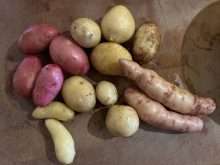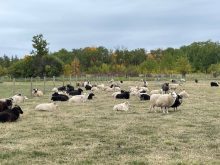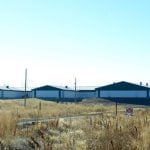The potato is a member of the solanum or Solanaceae family, made up of thousands of wild and cultivated species that range from deadly nightshade to tomatoes.
Commonly cultivated in farm gardens are potatoes, tomatoes, peppers, eggplants and tomatillos. Members of this family also include petunias, lobelias, tobacco and common weeds such as black nightshade and wild tomatoes.
Growing potatoes
Read Also

Seasoning for Korea’s culinary wave
Not unlike K-pop, Korean cuisine has become part of the international cultural tidal wave called Hallyu, Saskatchewan chef and writer dee Hobsbawn-Smith says.
Well, anyone and everyone can grow this crop and it’s simply very easy — or it can be, if you follow good growing procedures.
A few years back there were only a dozen or so potatoes to choose from, such as Netted Gems (also known as Burbank russet, Idaho baker, Gem or russet) which still make up some 70 per cent of North America’s potato crop production on average, Prairie provinces included. Gems were and still are the primary French fry potato. The rest of the Canadian crop are chip potatoes and table stock for grocery stores.
For the home garden, we had the choice of such early potatoes as Norland and Warba, Gems or the “new exotic” Yukon Gold developed at the University of Guelph. Yukon Gold had trouble initially getting on the market because it was yellow-fleshed and considered “unacceptable.” I was at the University of Guelph at the time of its release.
But eureka, we now have around 1,500 registered varieties of potatoes available in Canada. These “new” registered potatoes are of white, yellow, pink or purple flesh, come in a variety of shapes, sizes and skin colours, and are early- or late-yielding. My personal preference varieties are Gourmandine, Jennifer, Marilyn, Satina and Anya, a peanut pod shaped potato — fantastic flavours and shapes to suit all tastes.
Growing potatoes should be a cakewalk, but there are problems Prairie farm gardens can avoid.
Every potato you eat was a tiny tissue-cultured seedling seven to eight years previous. These seedlings are grown in greenhouses in their first year, followed by six stages of federally-inspected growing on seed potato farms in all of Canada. When you buy potato seed you buy clean, disease-free stock ready for your garden.
To grow these potatoes, observe the following:
- Do not plant potatoes after potatoes: follow a three- to five-year rotation to avoid soil-borne disease.
- Fertilize with a 10:10:10 type fertilizer.
- Plant seed in rows four inches (eight cm) deep in late April to early May.
- Potatoes should be allowed to sprout in a warm room for seven to 10 or more days before planting.
- Weed and hill up in early June, harvest in September or early October before the frost.
- Never plant “store”-bought potatoes. Intended for food, they have been sprout-inhibited and will never grow. Farmer’s market potatoes can be used for seed.
Potato problems
As farmers, colony potato growers and/or market gardeners, you are able to use insecticides to control problems in your potatoes. You can use deltamethrin or imidacloprid for control of Colorado potato beetles and tuber flea beetles. Home gardeners may not successfully grow potatoes just because of these two insect pests. I have seen potatoes ruined by tuber flea beetle tunnels, and Colorado beetles’ infestations so heavy that the tubers themselves become poisonous in their attempts to naturally fight off the beetle. The potatoes try and get rid of the Colorado beetle by producing a poison called solanine. This solanine gives the potato a sharp bitter taste and eating these tubers can make you very sick. I would say “Be very cautious of organically grown potatoes.”

If you wish to grow potatoes following Colorado or flea beetle infestations, try and get land well away from the “old” potato garden. Neither the tuber flea beetles or the Colorado beetles travel any distance from the infested area. If you wish to pick off and kill Colorado beetles, this must be a daily task as soon as the potato vines emerge from the ground. You must also control weeds such as annual nightshades and wild tomatoes, both of which are hosts to the Colorado beetle larvae.
For good crops of potatoes, like anything else, you need generous bagged fertilizer inputs that include nitrogen (N), phosphorous (P), potassium (K) and sulphur (S). If you use manure or compost of any kind, you run the risk of high levels of potato scab, a common soil microorganism that makes the potatoes very unsightly.
If you store your potatoes, they must be kept in the dark after the fall harvest, which must be done before a hard frost that will result in potatoes rotting in storage. Small quantities of potatoes can be put in net bags or large flowerpots and placed in black garbage bags and kept in a cold room or garage just above freezing. Kept just above freezing, your potatoes will be good for six to seven months before sprouting. Some potato varieties are more sprout-prone than others. In cold storage for a few weeks, the starches in the potatoes will change to sugars, which when fried give you that golden-brown colour.
If you need specific information on potato diseases, disorders and insect pests, go online and search up the publication Diseases and Pests of Vegetable Crops in Canada. I wrote up or edited the 40 or so common potato disorders and pests in this text.
Potato problems are numerous, but here I’ll deal with a few significant recurring problems in Prairie potato production for farms, colonies and market gardeners.
Late blight. Here today, gone tomorrow. It’s a disease that does not overwinter on the Prairies. The common strains of this disease also attack tomatoes.
Bacterial ring rot. Control of this very destructive disease was solved in Alberta — not by the Europeans or Americans, as one would have expected, but in Alberta and British Columbia.
Contaminated manure. Many potato crop failures occur on farms and home gardens annually because potato growers use cattle manures that contain picloram. This herbicide is used for pasture weed control and prairie roadside weeds. Hay treated with picloram passes unchanged from being eaten but the residual manure is toxic to potatoes even when there is only one part per million of this herbicide in the manure. Such contaminated manure also kills tomatoes, beans, peas, peppers and other members of these plant families. Avoid using cattle manure on farm gardens and other gardens.
Please check the internet textbook for more specific information, as well as extensive photographic illustrations of very many potato disorders.
Did you know that Canada’s McCain company produces 25 per cent of the world supply of frozen french fries, and that the three Prairie provinces last year produced almost as many potatoes (by weight) as the rest of Canada?
















